#disney's cinderella
Text
ROUND 4A, MATCH 1 OUT OF 2!

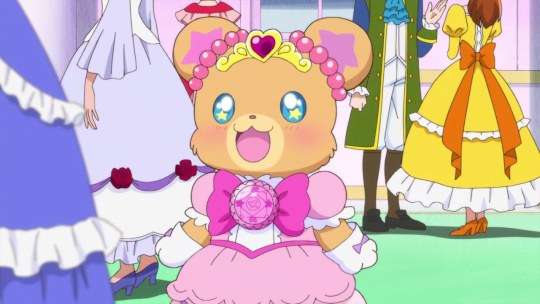
*Includes the original 1950 animated film, the 2002 sequel Cinderella II: Dreams Come True, and the 2007 sequel Cinderella III: A Twist in Time.
Propaganda Under the Cut:
Disney's Cinderella:
she is very iconic, she is super kind and has a beautiful dress
Submitting specifically because Cinderella III: A Twist in Time has lived rent-free in my head ever since I was a small child.
This Cinderella is most young (western) peoples introduction to this very story. Cinderella is so hopeful and by getting one small magical adventure, her whole life changes for the better. She is skilled and inspires such loyalty with her kindness that it’s hard to dislike her for any reason she gives. I’ve always been jealous of her ball hairdo too.
Walt Disney put all he had into this movie. And his favorite animation was the dress transformation scene. There’s a reason she is often front and center on the Princess group promotions.
she is the original. to me. probably the first exposure to cinderella for a solid chunk of people alive & on tumblr today. she is just a perfect encapsulation of everything that cinderella is, even if she's become warped in the public consciousness. also i'm pretty sure she's the reason why the glass slippers are so predominant in more recent retellings bc she is simply so iconic. 100/10 no notes 💜
She's maybe not the OG OG but she was one of the first animated Disney princesses and strangely enough it doesn't stop her from having an amazing personality. She's literally a slave but keeps being a nice person, forgiving and always doing her best. And the sequels absolutely didn't ruin her character. She's a sweet girl who tries to fit in but who's loyal to the person she is and who tries to change things always in a cute and sweet way to show people it's not that hard. She literally forgave Anastasia and tried to help her after all she did to her (the scene where the step-sisters destroy her dress still is terrifying to me)... she's awesome and deserves more recognition honestly...
(Mod's note: the following submitted specifically for Cinderella III: A Twist in Time, but I condensed the animated movies into one entry.) No she is not the same as the original Cinderella of 1950. This girl’s biggest chance was unfairly snatched away from her. When the Prince was brainwashed she was enough to get him to double take. She was so Right that their connection over powered magic. And she had to be rescued from a ship. And was almost crushed within a pumpkin! And finally had to expose another imposter, who turned out to be just another victim of Lady Trameine. This Cinderella fought harder for her love because she knew what True Love was like and she still was able to forgive those who asked for it.
(Mod's note: the following submitted specifically for Cinderella III: A Twist in Time, but I condensed the animated movies into one entry.) Listen yes it's the same Cinderella from 1950 but she has an arc in this one! It's Disney's greatest film!!
Listen I love them both but the animated Cinderella definitly shine in every single movie she has. And she has 3.
Vote for Cinderella because she deserves it and is still underrated in the Disney Princesses Franchise when she survived so much (ab*se... Lady Tremaine still terrifies me and she doesn't even have magical powers except when she steals the magic wand in Cinderella 3) Also one vote for Cinderella is one jump outside the window Henri is ready to do. Yes it's real.
Disney animated the original fairytale but definitely made it more magical and less creepy (like the birds making the step sisters blind? It gave me nightmares for ages). If I think: which one will I want to rediscover multiple times? Disney's Cinderella.
Plus Cinderella 3 is a masterpiece.
Mofurun as "Mofurella"
listen. they do an episode where they're all sucked into Cinderella and they make the trans teddy bear Cinderella. Incredible story writing, 10/10, no notes.
Mofurdella is even plot relevant, that episode is how they get the Rainbow Carriage for their group attack anyway MOFURDELLA FIRST CINDERELLA PRECURE EPISODE TO GET ONE MOFURILLION VOTES
#cinderpoll#round 4#round 4a#disney cinderella#disney cinderella animated#cinderella 1950#disney's cinderella#cinderella#mofurun#mofurella#mahou tsukai precure#mahou tsukai prettty cure#precure#pretty cure#fairytale#poll tournament#poll bracket#character polls#polls
122 notes
·
View notes
Text
Emotionally devastating animation scene poll part 2
#disney#walt disney#childhood trauma#dumbo#the little mermaid#mulan 1998#mulan disney#the fox and the hound#hunchback of notre dame#wreck it ralph#zootopia#disney's cinderella#pinocchio#disney's pinocchio
227 notes
·
View notes
Text
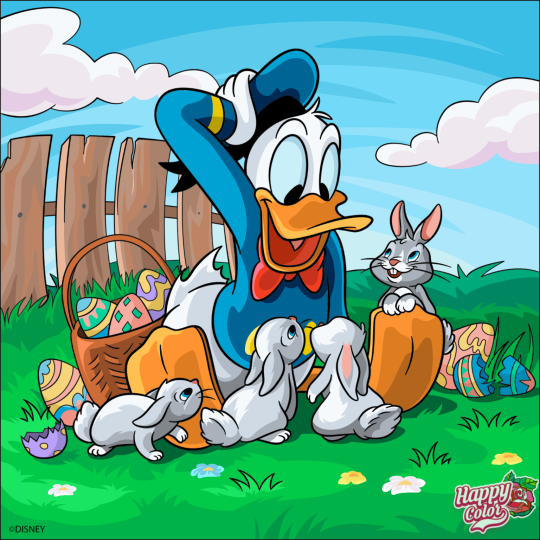
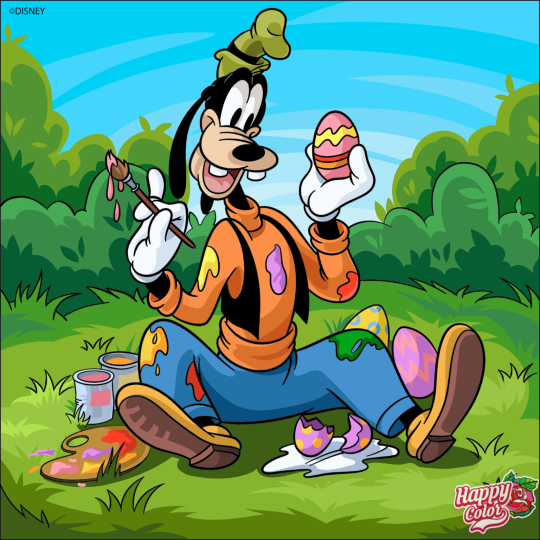

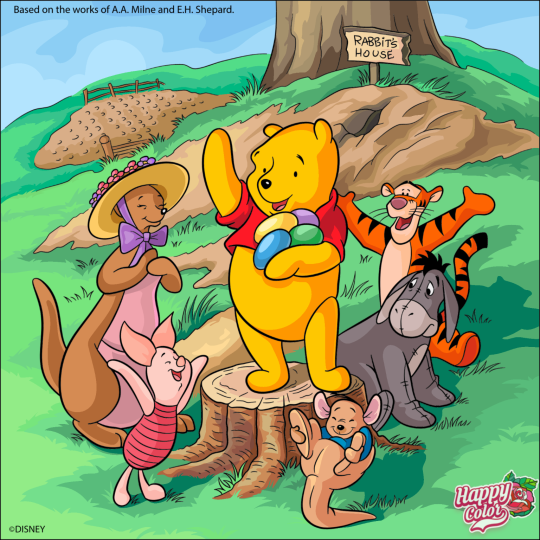




Happy Color app Disney Easter 2022 collection
#happy color#happy color app#disney#disney pixar#mickey mouse#minnie mouse#donald duck#goofy#pluto#winnie the pooh#pixar's cars#disney's cinderella#the little mermaid#pixar's brave#queue gotta be kidding me
26 notes
·
View notes
Text
Everybody’s missing Cinderella’s big point. Her superpower is “faith in kindness and courage.” Her superpower is not “ongoing desperate desire to be free.”

#Cinderella#Cinderella 2025#Cinderella 1950#Princess Cinderella#ella#Disney's Cinderella#live action Cinderella#lily james
59 notes
·
View notes
Text
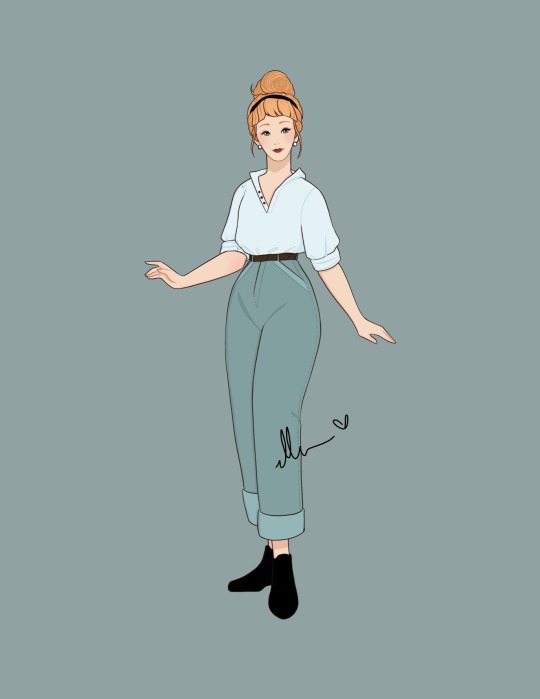

Modern Cinderella
For Cinderella's modern look I initially wanted to move in the direction of her 'maid' outfit. Most of her in-movie fashion is very 50s inspired and not that "out of fashion". So I decided on blue jeans and a rolled sleeve shirt that is more in the direction of a 'work' outfit (why all these "? I don't know they just keep happening) but then the color palette and headband are accidentally closer to her ballgown so.... either way she hopefully looks like Cinderella?
I am the artist!!! Don’t repost without permission & credit! Thank you! Come visit me over on: instagram.com/ellenartistic or tiktok: @ellenartistic
#cinderellla#disney's cinderella#modern disney#the great princess redesign#digital illustration#redesigning heroines#character design#ellenart#lnart#modern Disney princess#redesigning disney princesses#redesigning disney#modern fashion
215 notes
·
View notes
Text
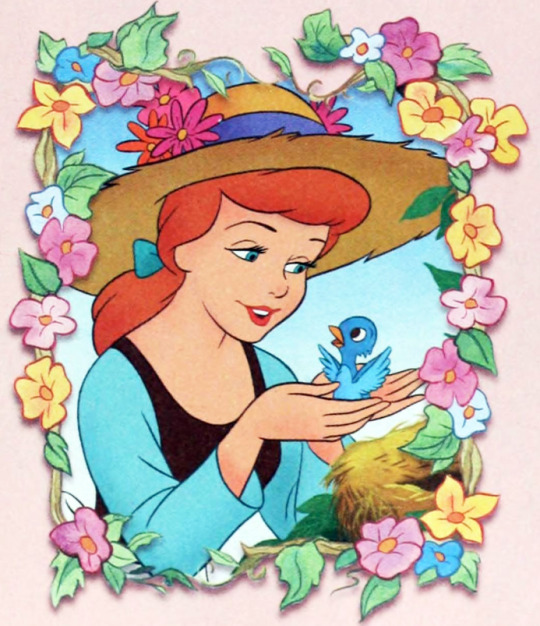

Beauties in Bloom
#beauties in bloom#snow white#cinderella#disney#disney's snow white#disney's cinderella#spring#flowers#spring flowers
91 notes
·
View notes
Text
Thinking of the Disney Cinderella Timeline
Here's how I think the Cinderella Disney animated movies are supposed to be viewed -- or basically, how it might have happened in linear time in the Disney Cinderella universe:
First, there's "Cinderella", of course. The one where she meets the Fairy Godmother for the first time and gets a lovely gown and glass slippers to go to a ball.

Then it's Cinderella 2's story "Aim to Please". And it makes sense, as it's clearly stated that the Prince and Cinderella have just returned to the palace after their marriage -- the marriage that happened at the end of the first movie -- before the Prince is whisked off by his father to attend to "Important Matters Of State". So of course that's what happened next.

After that, I'm guessing that "Tall Tail" happened sometime the same year Cinderella started taking over Princess Duties.

Because she says, "We sure have a lot of parties around here," indicating that the Banquet she dealt with in "Aim to Please" was likely not too far in the past. Or else, she's had a lot of parties to plan since then.
Now the next story is what is important. I think "Cinderella 3: A Twist in Time" happened next, not "An Uncommon Romance".
And then, after what happened in "A Twist in Time", with Anastasia not giving in to Lady Tremaine's scheme in the end, and the Prince and Cinderella marrying again, and them continuing to live their lives again...

After all that is likely when "An Uncommon Romance" happened.
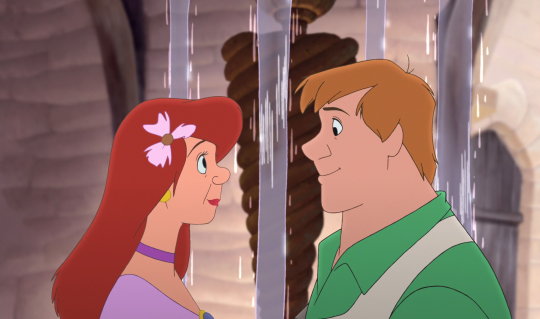
So the actual order is: Cinderella, Aim to Please, Tall Tail, A Twist in Time, and An Uncommon Romance.
Let me justify this idea:
First of all, in Cinderella 2, the mice were bringing up random stories they remembered. Except for the first story, where it's clearly stated that it happened right after the married couple returned and Cinderella was officially a princess, the other 2 stories could have happened at any time at all. (We don't know when the mice are writing these stories, after all. How many years it's been, or how much time has passed. We only know that they're writing stuff that's already happened.)

Secondly, look at the state of Cinderella's old house in "A Twist in Time". It's awful and the stepsisters are basically given the tasks of cleaning the large house.

And this actually fits with the first movie, which mentions at the beginning that the chateau was falling into disrepair as Lady Tremaine squandered all their riches on Anastasia and Drizella.

Basically, Cinderella being a servant was all that was keeping the house together. And after she left with the Prince, the state of the house obviously got worse.
But look at how the house looks in "An Uncommon Romance".

I didn't notice this the first time I watched Cinderella 2. But I certainly noticed after watching Cinderella 3.
But, the house falling into a further bad state makes sense since the house was already not maintained by anyone other than Cinderella at the very beginning of her story.
So here's my theory:
After Cinderella was taken to the palace by the Grand Duke, she likely put her family right out of her mind. And that makes sense. She's not vindictive at all. But after being treated as she was, keeping them far away from her and never turning in their direction again makes sense. If nothing else, she lays no claim to her house even though it was rightfully hers and she has been maintaining it for years. She just leaves them be and never interacts with them again.
But after the events of "A Twist in Time", while Lady Tremaine is a world-class b**** and horror, Cinderella, with her kind heart, and perfectly aware of how awful Lady Tremaine can be, likey decided that paying for the house's upkeep and inviting her stepsisters to balls might be necessary.

For one, she likely feels sorry for Anastasia, while also understanding how much courage it must have taken her to go against her mother. She also likely figured that Drizella was in the same position as Anastasia, even if she didn't show it or realize it. Finally, after Anastasia defied her mother in such a way, keeping an eye on them in general might have been necessary to ensure that she didn't mistreat Anastasia.
So, as generous as she is, Cinderella likely put aside her step-family's awful treatment of her to help her step-sisters (and to also likely keep an eye on her step-mother too).
This is further supported by the fact that, in "An Uncommon Romance", Anastasia has a music box with a couple that looks like the Prince and Cinderella. I doubt Lady Tremaine, as vindictive, malicious, and jealous as she is, would have let her have that -- unless she was now living under Cinderella's power.
Lady Tremaine even mentions them going to Cinderella's Ball. Yet another thing I doubt she would have let her daughters go to -- unless snubbing Cinderella that way would be pointedly "not good" for her.
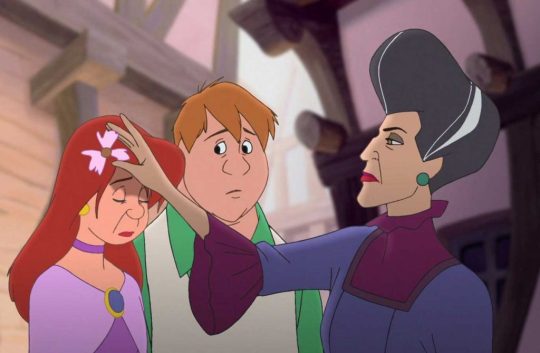
Yet another point was how, when Lady Tremaine finds Anastasia and the Baker together, while berating her and also manipulating her by saying that she only has her best interests at heart, she says nothing more when Anastasia declares that she is going to Cinderella's ball together with the Baker. No declarations of disowning her. No further manipulations or arguments or forbiddances. Like mentioning Cinderella's name and her ball left her with no option but to stalk away while just ordering Drizella to come with her. Like the only thing she could do now was to assert control over the one remaining daughter she still could control.
Very different from the woman in "A Twist in Time" who spelled the Prince's memories when he recognized that Anastasia was not the girl he had danced with at the ball.


Very different from the woman who sent spells right and left when Anastasia refused to marry the Prince in the end.

Rather, she held back probably because she knew she would land in hot water if she tried anything. Something was likely holding her in check: The fact that she was basically under probation and lucky to roam free now after attempting treason and murder in Cinderella 3.
Anastasia's reaction is also telling: She is cowed and sad as her mother and Drizella berate her. But the moment her mother says, in a seemingly kind way, that she only has her best interests at heart, it's like a switch flips in Anastasia. And that's when she declares she's wrong and that she IS going to go with the Baker whether she likes it or not.
It wouldn't be surprising if Anastasia heard her having "her best interests at heart" and remembered how her mother had tried to turn the wand on her when she had not married the Prince and instead said that she wanted someone to love her for herself.
And that, in fact, it was Cinderella who had stood up for her to protect her, and the Prince who had deflected the spell to protect Cinderella.
And finally, at the end of "A Twist in Time", the credits scene almost immediately shows the Baker meeting Anastasia. Which we know happens in "An Uncommon Romance". So "An Uncommon Romance" likely happens after the events of "A Twist in Time".

[ On another note, it really is more poignant when Anastasia tells Cinderella at the end of An Uncommon Romance, "Oh, thank you, thank you! I never dreamed I could be this happy!" and hugs her half-sobbing. Because, in A Twist in Time, she tells Cinderella, "I want what you had," and then, at the end, desperately tells her mother, "I want someone who loves me for me." And Anastasia gets that here. :) ]
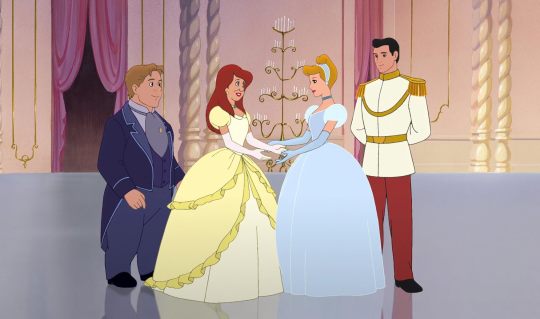
#disney's cinderella#disnerd#disney movies#disney#cinderella#cinderella 2#cinderella 2: dreams come true#cinderella 2 an uncommon romance#an uncommon romance#tall tail#aim to please#cinderella 2 tall tail#cinderella 2 aim to please#cinderella 3#cinderella 3: A Twist In Time#anastasia#anastasia tremaine#anastasia and the baker#drizella tremaine#lady tremaine#the baker#the prince#timeline of Disney's Cinderella#I spent a lot of time thinking of this#disney animation#movie analysis#animation#2d animation
30 notes
·
View notes
Note
Do you think the way people talk and discuss Walt's "Classic Three" (Snow White, Cinderella and Aurora) is accurate or close to what happens in the movies? I mean, they are always referred as excessively passive, weak, only interested on their looks (vain? superficial?), useless, beauty being their only good quality... And I ask myself, when was the last time these people watched the movies? Snow White negotiated her stay in the house, Cinderella survived a life of pure abuse & orchestrated her own escape from the tower, and, while not very much is shown about Aurora, she was about to sacrifice her personal happiness for the kingdom's sake (something Philip didn't have in mind)that takes courage! They don't wield swords but they are much stronger that they appear, and while I get some of the critique, I hate the "strong only means kicking butt" idea, like, it's incomplete, and superficial, and it can be reductive & dangerous (for the girls, and for the boys too!)
I have talked about this before in many posts, and others have talked about this way better than me, so I'll try to break down my opinion in a quite short and concise way. And as usual, you probably won't be surprised to find me again, neutral on those topic.
On one side: people are unfairly criticizing and judging too harshly the "original trio" of Disney movies. This has been explained by many people on this website, so I won't expand on this too much, but indeed, there is a mixture of superficial viewing of these movies, of not-contextualizing them, of projecting modern-day values and expectations over nearly century old pieces, and of a general need to criticize and rant about everything (especially big corporations and the "classics" of culture - whenever something becomes a classic, a backlash awaits). Cinderella is a much more surprising and strong character than you'd expect. These movies do teach the idea that being strong doesn't mean simply kicking everybody and proving yourself to be a lone wolf (especially since there's a strong focus on friendship in those stories). The whole "the prince kissing Sleeping Beauty in her sleep is rape culture" is ridiculous ; especially since in the Disney version it was made to be a true love kiss, between people who were in love, and the whole context was the breaking of a curse ; AND the actual rapist-origins of the story are from a 16th century Italian fairytale nobody knew about until the Internet dug it up in the 2010s. Even today many people who invoke the rapist-story are unable to tell you who wrote it or where it comes from, because they just latch onto the idea "Oh yes there's a rape story." and that's it, no more research for them.
Heck, Sleeping Beauty is even surprising for its time AND for the Disney criteria by having elderly, non-attractive female leads who do more than the actual male hero and ultimately are the true focus of the tale - the fairy godmothers. Same things with Snow-White - to make the dwarfs the equal of the titular Snow-White, even more to focus more character development and screen time on them rather than the princess, and to give them unique characterisation and treat them as people rather than plot-props... This was BIG, this was not something usual, and this was a game-changer. Overall - I say the same thing for fantasy literature - a lot of the "new" or "modern" twists people expect from today's fictions are awaiting you in the past. Everybody complains about traditional fantasy not having POC main characters or not having strong female lead that is not sexualized - Earthsea had all those by the 60s and 70s, and it was just as influential on fantasy as Lord of the Rings or Elric.
However... Recognizing that a lot of the criticism is unfair and overblown, and that the backlash is ignorant and caricatural does NOT mean we should just blindly worship and naively accept those movies as untouchable, sacred relics that cannot be criticize. If there is a backlash, it means there is a reason for such criticism to arise in the first place, and we must identify why - to give back the problem in its proper proportions, and not in the exaggerated state we are offered today.
So... The other side - why is this Disney trio not fitting our modern world?
And the answer is very simple. They are heroines of 17th and 19th centuries tales, that were adapted for an early 20th century American mindset. They are bound to age or be unfit for the 21st century. Placing them back into context allows us to understand how great, good or groundbreaking they were in their time - but it does not mean they hold up to modern-day characters. Some elements of the Disney movies aged better than ever, some are still resonating today, and this is what gives them an "out-of-time" feeling. Yet... yet there is a reason why the "Disney princess" had to evolve and had to change herself to fit a new audience. Why did the characters of Rapunzel and Elsa of Disney had such huge success and were beloved by the masses? Because they were answering early 21st century needs, society and expectations, the same way the original trio did for their time.
A character like Aurora of Sleeping Beauty couldn't work today because she literaly is a paper-thin character that does nothing throughout the story and is truly more of a MacGuffin than anything. Oh yes she speaks, has a song, has feelings and emotions - and there is this very progressive idea of having Aurora be unhappy and traumatized by discovering her princess heritage, which aged very well! But the rest? She is a baby ; then she sings about being in love ; then she cries about not wanting to be a princess ; then she sleeps ; then she is married. The story is done and moved by the interesting characters about her, but not by her - Maleficent wants to destroy Aurora, Philip wants to save Aurora, the fairy godmothers wants to protect Aurora... I do not recall which feminist created this theory, but there is the test of the lamp. If you can replace a female character by a beautiful lamp, this is bad for you. And unfortunately Disney's Sleeping Beauty "succeeeds" at the test of the lamp, since Aurora's massively passive involvment in the story makes her a perfect fit. The king and queen create the most beautiful lamp you ever saw ; Maleficent angry curses the lamp to be destroyed ; the fairy godmothers are tasked with keeping the lamp safe ; later the prince discovers the lamp in the woods and wants to have it for his living room, so he plans to return later ; meanwhile the fairy godmothers return the lamp to their rightful owners the king and queen, while Maleficent captures the prince who returned in hope of taking the lamp ; etc etc... It does not change the story one bit.
Another, even more obvious example, of the "age" of those characters - Snow-White. Disney's Snow-White is the very embodiment of the "50s housewife" cliche, and thus was a perfect fit for this first-half-of-the-20th-century American society. In the Grimm story, the little girl enters the house, takes the food, goes to sleep, and upon meeting the dwarfs they make a bargain of chores in exchange of protection. In the Disney movie? She cleans the house all by herself, without asking anybody, just in hope it will please people. Which is a very "fairytale" move... But still is perceived badly as just the typical idea that "A good girl cleans up the house, that we ask her or not". The fact Snow-White also acts as a mother figure for the dwarfs despite being a teenage girl is... yeah it is questionable and there's a whole baggage of the girl existing as solely a future mother and a housekeeper-in-training. Let's not even talk of the infantilization of the dwarfs just because of their small size despite being clearly much older than her...
So yeah, I always take a neutral stance on things (except for a few stuff), and this is no exception. There is an unfair treatment of the original Disney princesses, definitively, and people are misreading the original movies... But when we take a critical look we also have to recognize that these characters were designed for a given society and a given time, and that now they made their time, we do not need them anymore and we can move on to other characters while fondly remembering them or taking inspiration from them. Erasing these characters would be stupid and absurd - but it is just as stupid and absurd to try to cling onto them constantly and to try to make them fit everywhere and anywhere (yes I am taking a jab at Disney and their perpetual recycling and their favoritism of remakes over new movies...).
.
#disney movies#disney fairytales#disney princess#disney's snow white#snow white and the seven dwarfs#snow white#disney's sleeping beauty#aurora#disney's cinderella
24 notes
·
View notes
Text

Ok, so I re-watched the original Disney's Cinderella, got soft over 'So, this is love,' and had an idea for a fic, I may write:
Imagine it's a few days after Charming and Cinderella marry. She's still getting used to being treated like a person and princess. All she knows is doing housework for others. So, she's trying to clean and do tidying, won't listen to Charming when he asks her to take a break the first time.
So, when she's dusting windows, he sneaks up behind her and starts playfully tickling her:
"Take a break, Cinderelly! No more cleaning! Not today or ever!"
He's such a goofball and of course she complies, because her hubby convinces her that there's no need for constant cleaning and doing chores now. She's safe and protected from Lady Tremaine's bullshit, and can heal from years of abuse.
#melody's posts#banshee's headcanons#melody's headcanons#disney's cinderella#Cinderella x prince charming#Charmimg is a goofball I will accept no criticisms#I fucking love A twist in time too#Anastasia redeemed herself and became a better person as well
8 notes
·
View notes
Text

9 notes
·
View notes
Photo


Disney Princesses live in a weird realm.Ariel’s shifting between her mermaid and human forms,Naveen is still a frog,Rapunzel has the long blonde hair...
#Disney#Disney Princess#Aladdin#Disney's Aladdin#Princess Jasmine#Pocahontas#Sleeping Beauty#Princess Aurora#Tangled#Rapunzel#Beauty and the Beast#Mulan#Princess Tiana#The Princess and the Frog#Snow White#Cinderella#Disney's Cinderella#The Little Mermaid#Disney Ariel#Moana
101 notes
·
View notes
Text
ROUND 2A, MATCH 1 OUT OF 8!
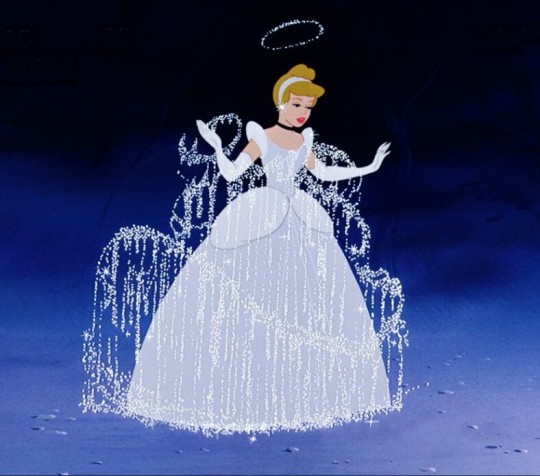

*Includes the original 1950 animated film, the 2002 sequel Cinderella II: Dreams Come True, and the 2007 sequel Cinderella III: A Twist in Time.
**Cinderella Romance, Romeo and Cinderella, and Cendrillon were all songs which were submitted. I condensed all Hatsune Miku songs into one entry.
Propaganda Under the Cut:
Disney Animated:
she is very iconic, she is super kind and has a beautiful dress
Submitting specifically because Cinderella III: A Twist in Time has lived rent-free in my head ever since I was a small child.
This Cinderella is most young (western) peoples introduction to this very story. Cinderella is so hopeful and by getting one small magical adventure, her whole life changes for the better. She is skilled and inspires such loyalty with her kindness that it’s hard to dislike her for any reason she gives. I’ve always been jealous of her ball hairdo too.
Walt Disney put all he had into this movie. And his favorite animation was the dress transformation scene. There’s a reason she is often front and center on the Princess group promotions.
she is the original. to me. probably the first exposure to cinderella for a solid chunk of people alive & on tumblr today. she is just a perfect encapsulation of everything that cinderella is, even if she's become warped in the public consciousness. also i'm pretty sure she's the reason why the glass slippers are so predominant in more recent retellings bc she is simply so iconic. 100/10 no notes 💜
She's maybe not the OG OG but she was one of the first animated Disney princesses and strangely enough it doesn't stop her from having an amazing personality. She's literally a slave but keeps being a nice person, forgiving and always doing her best. And the sequels absolutely didn't ruin her character. She's a sweet girl who tries to fit in but who's loyal to the person she is and who tries to change things always in a cute and sweet way to show people it's not that hard. She literally forgave Anastasia and tried to help her after all she did to her (the scene where the step-sisters destroy her dress still is terrifying to me)... she's awesome and deserves more recognition honestly...
(Mod's note: the following submitted specifically for Cinderella III: A Twist in Time, but I condensed the animated movies into one entry.) No she is not the same as the original Cinderella of 1950. This girl’s biggest chance was unfairly snatched away from her. When the Prince was brainwashed she was enough to get him to double take. She was so Right that their connection over powered magic. And she had to be rescued from a ship. And was almost crushed within a pumpkin! And finally had to expose another imposter, who turned out to be just another victim of Lady Trameine. This Cinderella fought harder for her love because she knew what True Love was like and she still was able to forgive those who asked for it.
(Mod's note: the following submitted specifically for Cinderella III: A Twist in Time, but I condensed the animated movies into one entry.) Listen yes it's the same Cinderella from 1950 but she has an arc in this one! It's Disney's greatest film!!
Listen I love them both but the animated Cinderella definitly shine in every single movie she has. And she has 3.
Hatsune Miku:
(General) NUMBER 1 WORLD PRINCESS!!! Miku miku oo ee oo :) also she is portrayed as Cinderella in a lot of songs.
(Cinderella Romance) [No Propaganda]
(Romeo and Cinderella) is hatsune miku. invented existing. references several other fairy tales.
(Cendrillon) Miku Miku Miku Miku Miku.
#cinderpoll#round 2#round 2a#cinderella#disney's cinderella#disney's cinderella animated#cinderella 1950#cinderella ii: dreams come true#cinderella iii: a twist in time#disney#disney princesses#dreams come true#a twist in time#disney's cinderella 1950#hatsune miku#vocaloid#cinderella romance#romeo and cinderella#cedrillon#fairytale#poll tournament#poll bracket#character polls#polls
64 notes
·
View notes
Text
Why can Cinderella understand animals??
#no other human in disney canon can just...understand aninals without magical transformation or the animal uniquely being able to talk#dragons don't count#disney#wsd watches cinderella#disney's cinderella#anyway i thknk its a very weird and unique trait#I think we should talk about it more
8 notes
·
View notes
Text
Random things about Cinderella (1950) I noticed/want to say after doing a psych project on it
I love the foreshadowing they do with the clock striking midnight when Cinderella is startled by the morning clock and she says "Even he orders me around." I never noticed it that way before.
The reason why no one recognizes Cinderella at the ball is because A) she seemingly wasn't allowed off her stepmother's property, so no one in town had ever seen her before or since she was a child, and B) when she gets there the prince immediately introduces himself and dances her away from everyone. The duke even pulls a curtain to separate her and him from the guests so they can dance alone. Almost no one gets a good up-close look at her except the prince.
I've said before on here that I think the prince in this movie was meant to be more of a symbolic personification of Cinderella's freedom rather than a literal character, and I still think that. However, I find it interesting that everything we know about the prince is told through others, not him. He doesn't get to be known. The only person he ever even gets to speak to is Cinderella. He also has a bit of character (relayed by others). His father laments that the prince is growing farther away from him the older he gets, he avoids responsibilities, and suggests that he's a hopeless romantic. It's also worth noting that the prince has no idea the ball is for the purpose of setting him up with a wife. He supposedly was led by the king to believe it was a welcome home ball, as he was away from home before (the ball invitees don't seem aware either until the night after the ball when they do the slipper fittings). [EDIT: I forgot to mention that I sappily like to interpret this as Cinderella, his eventual wife, being the only one who ever truly knows him, as he assumedly isn't close to the king or anyone else, so this is reflected in the fact that even us, the audience, don't get to know him like Cinderella must. Probably not the intention, but it's cute.] He also doesn't have severe facial blindness, he probably would've recognized Cinderella without the slipper but A) it was the king who thought of the whole slipper-fitting idea; all the prince supposedly said was that he'd marry the girl who wore the glass slipper, and B) He is explicitly not the one to do the slipper-fitting. The grand duke does it. But even the grand duke seems to recognize her before she gets the slipper on (he saw her up close briefly while she ran away and chased after her).
Also, as Cinderella runs from the prince, the other maidens there crowd him, so he can't get to her to stop her, but they only stop him to converse with him about how "lovely" she is, not because they want him, which is kinda wholesome. Again, no one was there to try and marry the prince because no one knew that's what the ball was for to begin with except the king and duke.
Cinderella is definitely very kind, but she knows the treatment she gets from her family is not right. She speaks somewhat passive-aggressively about them when they're not around. I like that touch.
When her stepfamily teases her over her excitement that she could go to the ball because she's eligible, she asserts that she's still a part of the family. Even though she's being abused, it's a type of abuse where she thinks her family must value her in some way. I think when her sisters ripped her dress apart was the moment she realized she wasn't a part of the family after all and that she wasn't loved/valued.
Lady Tremaine was so different from other Disney princess villains at the time. Allow me to go on for a bit. Compare her to the evil queen or Maleficent (who are also great). They have a very booming presences and everyone knows they are monsters, it's just that no one can stop them until the end of their stories. But Lady Tremaine knows how to fool people by having a motherly disposition. Not in a nurturing way, but in a stern, tough “love”, almost “calm” way. She never yells at anyone (just raises her voice) or acts traditionally evil in the way the evil queen or Maleficent do. More bite than bark I guess. For example, when she lets the step-sisters rip Cinderella’s dress, she simply tells them to come along afterwards and tells Cinderella goodnight like a mother might, but without affection with it, like a covert dig; she doesn't visibly get cross with Cinderella, but what she’s doing is still abuse. Even Cinderella seems to see her as a mother in one way or another before the dress ripping (I don't think Cinderella ever calls her "Step-Mother" again after the dress-ripping she allowed her sisters to do). She's very covert in her villainy. A very good depiction of an abuser. The only other Disney villain I can think to compare her to off the top of my head is Scar from the og Lion King when he was around anyone who wasn't the hyenas, but even then he dropped the act eventually after becoming king. Lady Tremaine never really does.
I also like the detail that after the ball when trying to tell the step-sisters about the shoe-fitting, she asks Cinderella, “Where are my daughters?” excluding Cinderella from being her daughter even though she should be. She really only sees her as a maid.
Cinderella's pink dress has a lot of bows, and at the beginning of the film, we see her when she was younger and the dress she wore as a child also had bows and was in a somewhat similar style. Her childhood dresses were probably taken away by Lady Tremaine when her dad died. Makes me wonder if Cinderella redesigned her mom's dress with her dress from youth in mind, as she certainly hadn't worn a nice dress since she was a kid. And if so, what would that mean? Was she just feeling nostalgic? Or had her sense of style not matured since childhood because she had been made to wear nothing but rags for who knows how long? Is her only frame of reference to what her own personal style is based from her childhood dresses? I just think it's kinda intriguing. The pink dress always felt explicitly young for Cinderella.
Cinderella's voice is so cute. Not just her singing, but her voice in general. Ilene Woods, love of my life apparently.
People often complain about Cinderella marrying the prince the day after the shoe fit, but Disney's version never specifically states that the wedding is the day after the slipper scene, it just comes right after it. Who's to say how much time there was in between scenes. There are versions that do say that it was the next day, so I guess people conflate different versions together in their heads. This is why it's important to watch films with your brain on before criticizing them for things they didn't do.
I never thought too deeply of it, but when Cinderella sings the words "So this is love" she really is (re)learning what love is. It's a realization. She likely hasn't felt love from another human being since her father died. Or rather she thought she was loved in some way, but then realized she wasn't when her dress was ripped. So now, with the prince, she has a better understanding of what it's like to be properly loved. Imagine hating this girl. 🩵
#this is basically all the stuff i couldn't fit in my brief college paper because it was irrelevant to it's topic#cinderella#disney's cinderella#cinderella 1950#disney#walt disney#walt disney animation studios#the little glass slipper#charles perrault#fairy tales
4 notes
·
View notes
Text
Once Upon a Time
An essay about the influence of one of the co-founders of the Writers Guild on Disney’s Cinderella

Disney’s Cinderella is a film obsessed with time. The thrumming of midnight is the most obvious example, but that same tower clock interrupts Cinderella’s opening song, too, as she attempts to convey the possibilities provided by dreaming in “A Dream Is a Wish Your Heart Makes.” “Oh, that clock! Old killjoy,” she complains and goes onto connect it to her position of servitude, explaining how the clock itself orders her around
The vocabulary of “time” saturates the dialogue. The word “time” is mentioned thrice in the prologue alone! Cinderella’s stepmother, Lady Tremaine, is the next to bring up the word. She accuses her step-daughter of having too much “time on [her] hands” that should be put to better use laboring for her and her stepdaughters in the house. Cinderella’s fairy godmother is also clued into the values of time. “Even miracles take a little time,” she remarks. Both surrogate mothers link time to work and production. How much someone can clean up, get done, maintain, and maybe even transform is dependent on the amount and use of their time.
Another kind of time distinct from the labor equation enters the fray at the palace. The prince’s ball is initiated by his father’s insistence that “it’s high time [his son] married and settled down,” so that he can see his grandchildren before he passes (Noticeably the interest of reproduction is an outside pressure rather than a motivation for the Prince and completely irrelevant to Cinderella herself). This ticking “high time” is a biological clock that connects back to the mention in the prologue of the “untimely death” of Cinderella’s father. It sets an enforced window of time between birth and death in which we are given to live fully.
The mice’s working song as they altruistically conceive to construct Cinderelly’s dress for the ball seems to most encapsulate the film’s perspective on time. “Every time she find a minute, that’s the time when they begin it!” Her animal friends complain that any moment Cinderella begins to encounter freedom and selfhood, the stepfamily increases its labor demands on her to claim ownership of that moment in time. Cinderella’s time to dream up solutions to her situation or even to dream up a comforting thought as she endures it is constantly being denied by the demands of her stepmother and stepsisters, who act more like employers than family. They rip away the scraps of leisure time she collects for herself in the same way they rip away her dress, becoming possessive of the scraps they had thrown away only once they see Cinderella making a personal life out of them. The expectation is that her time should only work towards maintaining the order (both in cleanliness and social standings) of the household. A dream may be a wish your heart makes, but with a stepfamily like that, who has time to dream?
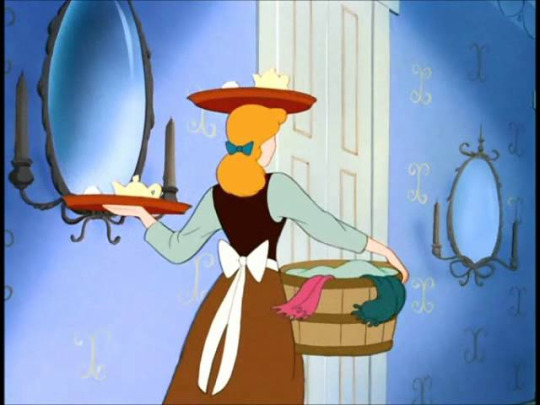
Cinderella in its Time
“We wonder,” activist-poet Gwendolyn Brooks wrote in her poem “kitchenette building,” which was published in her Pulitzer Prize-winning collection A Street in Bronzeville in 1945. It was published only a couple years before Cinderella’s production began. She meant wonder in the same vein that Cinderella dreams, wide-eyed, hopeful, and so often thwarted. “We wonder. But not well! not for a minute!” because “Dream,” she explained, only “makes a giddy sound, not strong like ‘rent,’ feeding a wife,’ ‘satisfying a man.’ The poem demonstrates how the deprivation of time—and the deprivation of resources one can otherwise accrue when given time—deny the lower classes the possibility of even imagining beauty and fantasy into their lives and futures. It creates a permanent relationship to the desperation, disgust, and disappointment that have to be immediately dealt with—garbage in the hall, onion fumes, and lukewarm shower water. Perhaps dreams exist amongst these lives, but no one has the time to notice them and take stock, which means that no one especially has time to transform their dreams into reality.
It’s no stretch to imagine a connection between Gwendolyn Brooks’s work and Disney’s Cinderella. I’ve already mentioned their chronological closeness but there’s also Cinderella’s uncredited screenwriter Maurice Rapf. He was the cofounder of the screenwriters guild (which grew into the Writers Guild of America, the organization currently on strike in 2023. He would later be blacklisted in Hollywood in 1947 due to his association with the Communist Party USA (hence the “uncredited”). He was also brought on, due to his aggressive anti-Uncle-Tom stance, to shape up Song of the South before being pulled from the project after only seven weeks due to disagreements with the infamous lead screenwriter for the film. That a vehement Marxist and antiracist like Maurice Rapf might have more than a passing familiarity with Brooks’s poetry seems more than likely, and it encourages us to read the film more deeply with this kind of lens.
Cinderella’s Histories

It’s well known that the Cinderella story type is an old folktale with versions across a variety of cultures. Disney’s Cinderella draws heavily on Charles Perrault’s French version from 1697. The pumpkin, the fairy godmother, the glass slipper: all Perrault. But the film’s far from a truly faithful adaptation.
Some strange anachronistic names permeate the film. Perhaps you remember the round and adorable mouse, Gus. Do you recall, though, that Cinderella names him Octavius, then christens him Gus for short? Gus, of course, is short not for Octavius but for Augustus. It’s a reference to the Roman emperor who began life with the name Octavius as part of the commoners of ancient Rome, (the plebians) before rising to the highest position of Caesar, receiving the name Augustus and ushering in the Pax Romana, an unprecedented period of peace within the Roman Empire. In the context of the film, his name is used to reference crossing the class barrier to achieve a fairytale happy ending.
Another name, perhaps less unusual, that still beams within a Marxist reading is Cinderella’s stepsister, Anastasia. While of Greek origin, the film pays little respect to its meaning in that language of “resurrection.” It points rather to a notoriously non-Disney princess, instead. The fantasy of Anastasia Romanov’s survival of the Bolshevik Revolution was well established by the time Cinderella was being written. Drawing an even more direct connection, Rapf, whose semester abroad in the USSR in the 1930s (and terrifying visit as a Jew through Nazi Berlin on his way back) inspired his adamant communism. The writers of Cinderella place their Anastasia as one of the stepsisters in a position of power and privilege that harms the laboring protagonist, Cinderella. While it doesn’t direct the stepfamily to a firing squad, through this choice the film refuses to romanticize the Romanovs and the aristocratic class and mindset they represent more broadly.
And They Lived Happily Ever After

If we take a Marxist reading to be true, then we’re forced to ask the question: why does Cinderella ascend to royalty? The film closes with an image of what is perhaps the most iconic happy ending in the fairytale film genre with Cinderella and Prince Charming riding off in their honeymoon carriage with a final kiss. It replaces Snow White’s castle in the clouds and all its religious allegory for a much more secular conclusion. Logistically, this marriage would bring Cinderella into the fold of aristocracy, but the visuals the animators depict de-emphasize the castle, the class status, and even the ceremony that grants her access to the upper crust.
In the final minute of the film, Cinderella is once again sprinting away from the castle and the king, descending the stairs rather than ascending to a throne. The bells of the clock tower chime away again and the motif of her lost slipper reoccurs, reminding the audience of Cinderella’s urgency, the limited window of time offered to her to find personal freedom. It also provides an opportunity for the king to kneel before her and become her foot servant. Still, she doesn’t remain to take charge of him or the kingdom, she continues her descent away from royalty towards the Public with the person who disregarded class divisions.
Then there’s that final famous image in the carriage, so pervasively symmetrical. A pyramid structure is bordered by natural elements. Then, making the escape from unregulated servitude possible for Cinderella, a laborer, the carriage driver, sits atop the triangle, signaling his power and importance to the narrative’s happy ending. When we transition to the pages of the book that close the film, his person is replaced by a crown.
At the center, Cinderella and her prince consummate their union. From the regulated actions of labor and class, they are escaping into the realm of the carnal. Bodily desires are finally allowed to take precedence for Cinderella instead of the nagging bells that demand she wake up and get to work. The government of Time instituted by the aristocracy on Cinderella as a member of the working class yields to the cries and celebrations of the public and to Cinderella’s own pleasure. “Ever after” is beyond the reach of Time. And, it’s not heavenly like Snow White’s, but in a realm where one is no longer alienated from their own body, its needs and its rhythms.
Back in her rags after her encounter at the ball, Cinderella remarks, “I guess I forgot about everything, even the time…” The discourse around Cinderella has criticized its marriage plot romance, but that romance signifies the ability of connection and union—at the personal level, yes, but also in a socialist fashion—to psychologically and politically help liberate oneself from the many hegemonies that render life unnecessarily laborious, unrelenting, and full of drudgery. Life, when made in partnership with others instead of hierarchies, could feel like a fantasy flying by, like a timeless dream.
9 notes
·
View notes
Text
I haven’t kept up with Disney’s Cinderella Lore in literally two decades. Is Cinderella’s step sister still with the baker?
9 notes
·
View notes